Why SEM is preferable to regression?
Structural equation modeling is carried out in two steps in IBM AMOS
1) Measurement model – confirmatory factor analysis
2) Structural model- testing of hypothesis:
The advantage of the confirmatory factor analysis is that it provides stricter test of unidimensionality (Gerbing & Anderson, 1988). CFA is an important analytical tool for establishing and confirming the factor structure of the construct given the fact that results of CFA differ from exploratory factor analysis (Gerbing & Anderson, 1988). Relying on the output of exploratory factor analysis is not recommended for assessing the different dimensions of a construct. Therefore if you have a construct with multiple dimensions it is recommended that you carry confirmatory factor analysis rather than exploratory factor analysis. This is the first advantage of structural equation modeling.
SEM is a superset of possible regression models. Any regression model can be expressed as the structural model. Structural equation modeling allows multiple dependent variables to be included in the model. Regression analysis allows only one dependent variable in the analysis. Therefore if you have more than one dependent variable model then it is recommended that you use structural equation modeling using IBM AMOS rather than carrying out regression analysis.
Further SEM handles latent variables to account for the measurement error while regression analysis assumes the measurement of the latent construct is error free (Bollen & Long, 1992).
Thus, SEM results and estimates are much more robust as compared to regression analysis. Therefore structural equation modeling is preferred over regression analysis.

